Assessment of Age-Friendly Streets in High-Density Urban Areas Using AFEAT, Street View Imagery, and Deep Learning: A Case Study of Qinhuai District, Nanjing, China
Abstract
1. Introduction
2. Literature Review
3. Materials and Methods
3.1. Research Framework
3.2. Study Area
3.3. The Age-Friendly Environmental Assessment Tool
3.3.1. Construction of the AFEAT Age-Friendly Street Assessment Model and Indicator Quantification
- (1)
- Safe Mobility
- (2)
- Environmental Amenities
- (3)
- Accessible Amenities
| Age-Friendliness Dimension | Indicator | Elements | Composite Weight |
|---|---|---|---|
| Safe Mobility(A) | Traffic Safety (A1) | traffic light | 0.4515 |
| streetlight | 0.3563 | ||
| signboard | 0.1178 | ||
| bridge | 0.0745 | ||
| Transit Accessibility (A2) | sidewalk | 0.5187 | |
| canopy | 0.2875 | ||
| stairs | 0.0646 | ||
| road | 0.1291 | ||
| Barrier-free Transit (A3) | utility pole | 0.1106 | |
| railing | 0.4716 | ||
| ashcan | 0.1148 | ||
| warning sign | 0.3030 | ||
| Walkable Environment(B) | Airflow Optimization (B1) | sky | 0.4597 |
| building | 0.3036 | ||
| ceiling | 0.1302 | ||
| wall | 0.1064 | ||
| Noise-reducing Greenery (B2) | plant | 0.5221 | |
| bushes | 0.2384 | ||
| grass | 0.1088 | ||
| fence | 0.1307 | ||
| Accessible Amenities(C) | Universal Access Infrastructure (C1) | bench | 0.5097 |
| box | 0.2403 | ||
| door | 0.118 | ||
| pot | 0.132 | ||
| Organized Parking (C2) | car | 0.5238 | |
| bus | 0.2892 | ||
| truck | 0.0624 | ||
| van | 0.1246 |
- (4)
- Healthcare Services
- (5)
- Leisure and Active Living Environment
- (6)
- Social Participation and Interaction
3.3.2. Weighting of AFEAT Indicators
3.4. Data Source and Analysis
3.4.1. Semantic Segmentation with PSPNet
3.4.2. Accessibility and Kernel Density Analysis Based on POI Data
- (1)
- POI Processing and Age-Friendly Screening
- (2)
- Walking Accessibility Analysis of POI Facilities
- (3)
- Kernel Density Estimation
| Type of POIs | Description | Number |
|---|---|---|
| Medical Facilities | Facilities that offer accessible and healthcare services, such as hospitals and clinics. | 52 |
| Medical Services | Pharmacies | 328 |
| Senior Care Facilities | Specialized institutions that provide residential care, daily life assistance, and medical monitoring for elderly individuals. | 41 |
| Green Spaces | Public open spaces designed to be safe, accessible, and restorative for all ages, especially older adults. | 60 |
| Daily Markets | Daily supply venues such as wet markets or community supermarkets with barrier-free entry | 282 |
| Volunteer Service Centers | Community-based centers that mobilize volunteers to provide companionship, home assistance, or administrative help for elderly residents | 22 |
| Community Committee | Local governance bodies that coordinate elderly services, mediate local issues, and promote intergenerational engagement through accessible communication channels and outreach programs. | 109 |
| Bus Stops and Subway Stations | Public transport nodes designed to accommodate older passengers with features like seating, ramps, tactile paving, low-floor buses, and audible announcements. | 276 |
3.4.3. Random Forest Model for Assessing Street Age-Friendliness
- (1)
- Data Sources and Preprocessing
- (2)
- Modeling and Training Process
4. Results
4.1. Overall Age-Friendliness of Streets
- For Safe Mobility (Dimension A), streets with a medium level of age-friendliness account for the highest proportion (54.46%), whereas those with low age-friendliness represent the smallest share (19.80%).
- In the Pleasant Environment (Dimension B), a significant portion of streets fall within the high (36.14%) and medium (45.05%) categories, with only 18.81% classified as low.
- Facility Friendliness (Dimension C) is primarily characterized by medium-level streets (46.53%), followed by high-level (31.19%) and low-level (22.28%) streets.
- Similarly, Health Security (Dimension D) shows a dominant presence of medium-level streets (44.06%), while high-level streets constitute 34.16%, and low-level ones make up 21.78%.
- The Active Living Environment (Dimension E) performed notably well, with high and medium levels nearly evenly distributed (42.57% and 42.08%, respectively), and the lowest share in the low category (15.35%).
- In contrast, Social Connectivity (Dimension F) demonstrates a relatively higher proportion of low age-friendliness streets (27.23%), while medium and high levels are comparable at 37.13% and 35.64%, respectively.
4.2. Correlation Analysis of Multi-Level Indicators in the AFEAT Model
4.3. AI-Derived Spatial Elements and Their Alignment with AFEAT Scores
4.4. Spatial Distribution Characteristics of Age-Friendly Pedestrian Streets
4.4.1. Safe Mobility
- There is distinct spatial differentiation in the age-friendliness of streets within Qinhuai District. Streets with high safe mobility scores are mainly located in core areas such as Xinjiekou and Fuzimiao. As shown in Figure 6a, Zhongshan South Road and Hongwu Road have traffic light densities of 0.0013 and 0.0012 respectively, significantly exceeding the district average of 0.0008 ± 0.0003. Chaoku Street benefits from sufficient nighttime lighting with a streetlight density of 0.0011. Pedestrian infrastructure on roads like Xuguangli (sidewalk ratio = 0.0553) and Saozhou Alley (0.0730) meets width and continuity standards, creating a high-quality walking environment overall.
- Moderate Age-Friendliness Streets are mainly distributed in a fragmented spatial pattern on the east and west sides of the southern old city, with common issues including a lack of traffic signals (e.g., Jiujiuchang Road, traffic light density = 0.0002), discontinuous sidewalks (e.g., Caixia Street, sidewalk ratio = 0.0063), and missing barrier-free facilities such as tactile paving and ramps (e.g., Junsi Alley).
- Low age-friendliness streets cluster in the northeastern periphery of Qinhuai District, including areas like Xujia Alley, Junong Road, and Zhongheqiao Road. These areas generally suffer from insufficient nighttime lighting, encroachment of pedestrian space by non-motorized vehicles and shop displays, and severe lack of barrier-free accessibility facilities, posing high risks to elderly pedestrians.
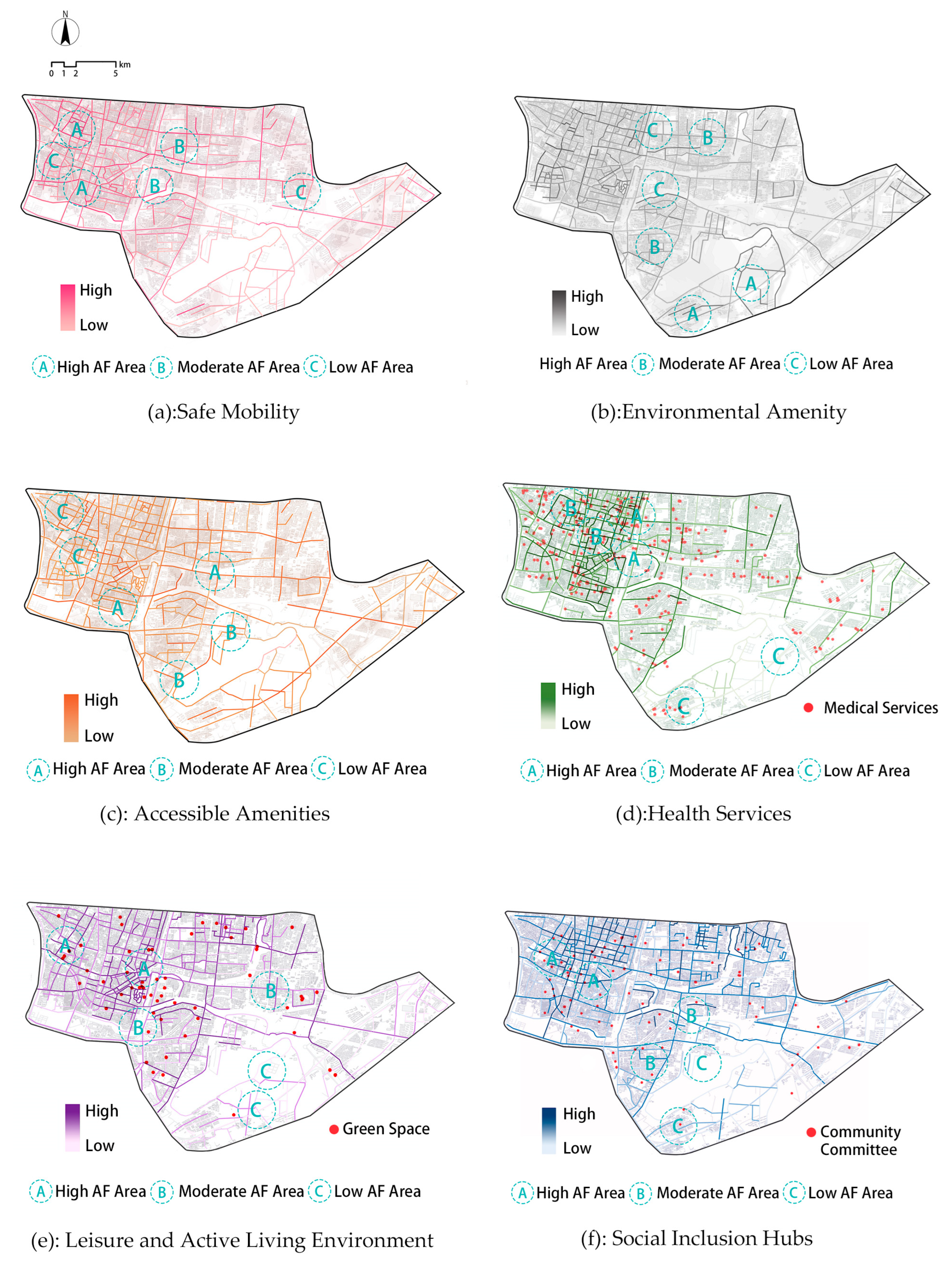
4.4.2. Environmental Amenities
4.4.3. Accessible Amenities
4.4.4. Healthcare Services
- High Age-Friendliness Roads (average score 3.90, accounting for 34.16%) are mainly concentrated in the southeastern part of Qinhuai District, such as Changfu Street (D = 4.79), Huowaxiang (D = 4.19), and Baixia Road (D = 4.71). These roads are adjacent to comprehensive hospitals and community medical institutions with elderly rehabilitation functions. The coverage rate of medical facilities within a 15-min walking radius reaches 85%, with pharmacy density as high as 5.4 stores/km2, indicating strong overall health service support capacity.
- Moderate Age-Friendliness Roads (average score 2.74, accounting for 44.06%) are mostly located in the transitional old city areas such as Fuzimiao and Hongwu Road, including Mafu Street (D = 2.83) and Dongtiegian Alley (D = 2.75). Although pharmacies are relatively densely distributed (accessible within an 800-m service radius), the coverage rates of hospitals and elderly care institutions are only about 45%, revealing service type imbalances and a single-resource structure.
- Low Age-Friendliness Roads (average score 1.59, accounting for 21.78%) are primarily distributed in the northern and western edges of Qinhuai District, including Chaiyuan North Road (D = 1.38), Guangsheng Road (D = 1.00), and Guangyang Road (D = 1.00). These roads face severe shortages of health resources: only 28% of roads have hospitals reachable within 15 min, pharmacy density is below 0.8 stores/km2, and 41% of roads fall within blind spots for elderly care facility coverage. Elderly residents here face notable deficits in daily health access and emergency response capability.
4.4.5. Leisure and Active Living Environment
- High Age-Friendliness Roads (average score 4.35, accounting for 44.1%) are primarily concentrated along the Qinhuai River scenic belt and adjacent densely populated residential areas, such as Wufu Lane (E = 5.00), Zhanyuan Road (E = 5.00), and Honghua Road (E = 4.53). These streets possess strong synergies between living convenience and leisure space: park and green space coverage within a 15-min walking radius reaches 91.3%, while daily market density is 6.4 locations/km2. Residents can easily walk to green spaces and supermarkets, with well-developed street resting facilities and strong spatial continuity. The overall environment supports elderly daily travel and social activities effectively.
- Moderate Age-Friendliness Roads (average score 3.07, accounting for 34.2%) are mostly located in the northern and northeastern transitional zones of Qinhuai District, including Chaoxie Lane (E = 3.12), Guanghua Road (E = 2.50), and Chenguang Road (E = 2.00). These streets show a moderate foundation in daily market accessibility, with coverage rates reaching 82%, but relatively insufficient green space provision. Park coverage within a 15-min walking radius is only 65%, indicating some functional disconnections and spatial fragmentation.
- Low Age-Friendliness Roads (average score 1.50, accounting for 21.8%) are concentrated mainly in the peripheral areas of the Daxiaochang neighborhood, with typical streets including Hongguang Road (E = 1.71), Guangsheng Road (E = 1.00), and Guangyang Road (E = 1.00). These areas face severe shortages in both living services and green recreational resources: park green space walkability is merely 12%, and the 15-min service coverage of daily markets is only 45%. The severe lack of service facilities limits elderly residents’ daily travel and outdoor activity opportunities, hindering the achievement of healthy aging goals.

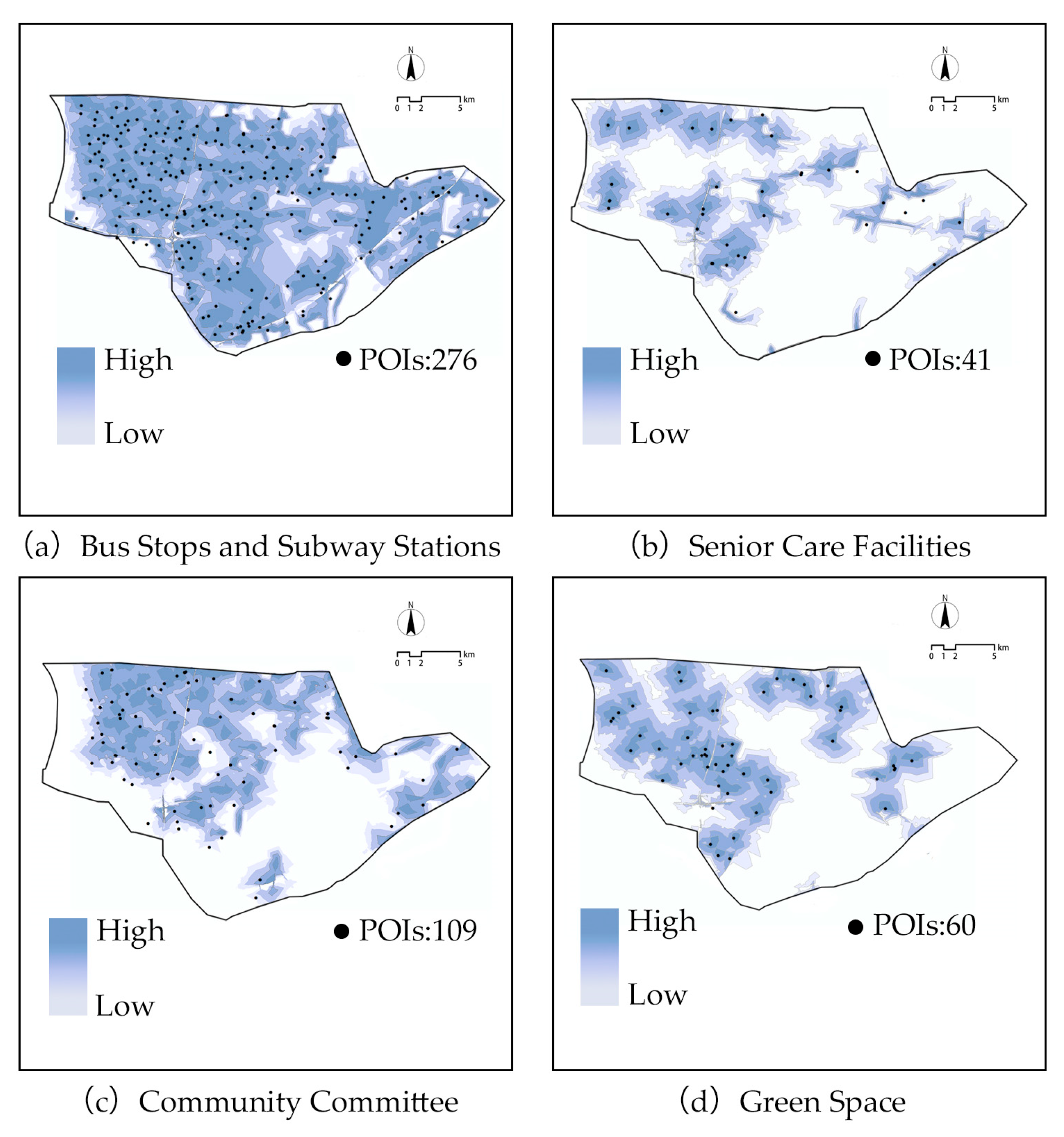
4.4.6. Social Participation and Interaction
- High Age-Friendliness Roads (average score 3.90, accounting for 35.6%, n = 72) are primarily concentrated in urban core areas such as Xinjiekou and Fuzimiao. Typical roads include Zhanyuan Road (F = 4.62), Chaoku Street (F = 4.48), and Dashiba Street (F = 4.50), featuring well-established community support systems: volunteer service center coverage within a 15-min walk reaches 95%, community committee accessibility is 93%, and bus and subway station density stands at 8.2 stations/km2. Most roads have established a “three-tier elderly care service system,” with age-friendly renovations of transit facilities achieving 100%.
- Moderate Age-Friendliness Roads (average score 2.74, accounting for 37.1%, n = 75) are mainly distributed in the transitional northwest and southwest zones of Qinhuai District, such as Muzhong Road (F = 2.74), Daxiaochang Road (F = 2.71), and Daming West Road (F = 2.71). Although community organization coverage reaches 70%, the degree of professional elderly care services remains below 45%, and only 62% of bus stops have undergone age-friendly renovations. This indicates an incomplete public service system with resource allocation gaps.
- Low Age-Friendliness Roads (average score 1.77, accounting for 27.2%, n = 55) are predominantly located in the urban periphery and western areas, including Fuhua Road (F = 1.11), Dongguashi Road (F = 1.00), and Dongfengqiao Road (F = 1.00). These areas face triple challenges: volunteer hub coverage is below 25%, community organization service radii generally exceed 800 m, and public transit connectivity is poor, with average waiting times exceeding 12 min. The districts are mainly residential with low functional mix, leading to narrow social spaces for elderly residents and significantly heightened risks of social isolation.
5. Discussion
6. Conclusions
Author Contributions
Funding
Institutional Review Board Statement
Informed Consent Statement
Data Availability Statement
Acknowledgments
Conflicts of Interest
References
- Wang, Y.; Li, X.; Chen, J.; Zhou, Y. Perceived versus measured neighborhood environments and their association with older adults’ well-being: Evidence from Xi’an, China. Cities 2022, 121, 103489. [Google Scholar]
- Wang, S.; He, S.; Webster, C. Environment, perception and subjective well-being in Guangzhou, China: A multilevel analysis. Urban Stud. 2021, 58, 2467–2486. [Google Scholar]
- Yue, W.; Chen, Y.; Zhang, H.; Liu, Y. Green space exposure, urban facilities, and mental health of older adults: Evidence from Chinese cities. Health Place 2022, 74, 102767. [Google Scholar]
- Aliyas, Z. Physical, mental, and physiological health benefits of green and blue outdoor spaces among elderly people. Int. J. Environ. Health Res. 2021, 31, 703–714. [Google Scholar] [CrossRef] [PubMed]
- He, L.; Zhang, F.; Liu, Y.; Lin, H. Spatial inequalities of elderly service facilities in Chinese megacities: Accessibility, equity and policy implications. Habitat Int. 2023, 132, 102735. [Google Scholar]
- Chen, J.; Wu, J.; Xu, Y. Evaluating the spatial distribution of elderly care facilities in China: Balancing demand and supply in high-density cities. J. Urban Plan. Dev. 2023, 149, 04023025. [Google Scholar]
- World Health Organization. Handbook for Age-Friendly Cities and Communities; WHO: Geneva, Switzerland, 2023.
- Government of China. The 14th Five-Year Plan for National Aging and Elderly Services; State Council of the People’s Republic of China: Beijing, China, 2021.
- Yao, Y.; Liang, Z.T.; Yuan, Z.H.; Liu, P.; Bie, Y.; Zhang, J.; Wang, R.; Wang, J.; Guan, Q. A human-machine adversarial scoring framework for urban perception assessment using street-view images. Int. J. Geogr. Inf. Sci. 2019, 33, 2363–2384. [Google Scholar] [CrossRef]
- Han, X.; Zhang, F.; Liu, Y. Deep learning-based urban perception mapping with street view images. Comput. Environ. Urban Syst. 2022, 94, 101777. [Google Scholar]
- Centre on Aging, University of Manitoba. Age-Friendly Cities Project Portage la Prairie, Manitoba, Canada: A Report Prepared for the City of Portage la Prairie; University of Manitoba: Winnipeg, MB, Canada, 2007. [Google Scholar]
- Choi, Y.; Seo, M.J.; Oh, S.H. Walkability analysis of Busan’s urban residential zones. KSCE J. Civ. Eng. 2016, 20, 2535–2547. [Google Scholar] [CrossRef]
- Chen, M.; Cai, Y.; Guo, S.; Sun, R.; Song, Y.; Shen, X. Evaluating implied urban nature vitality in San Francisco: An interdisciplinary approach combining census data, street view images, and social media analysis. Urban For. Urban Green 2024, 95, 128289. [Google Scholar] [CrossRef]
- Seresinhe, C.I.; Preis, T.; Moat, H.S. Quantifying the impact of scenic environments on health. Sci. Rep. 2015, 5, 16899. [Google Scholar] [CrossRef] [PubMed]
- Mohammed, M.; Antonio, P. A model-based approach to select case sites for walkability audits. Health Place 2012, 18, 1323–1334. [Google Scholar]
- Franke, T.; Tong, C.; Ashe, M.C.; McKay, H.; Sims-Gould, J. The secrets of highly active older adults. J. Aging Stud. 2013, 27, 398–409. [Google Scholar] [CrossRef]
- Alfonzo, M.A. To walk or not to walk? The hierarchy of walking needs. Environ. Behav. 2016, 37, 808–836. [Google Scholar] [CrossRef]
- Akpinar, A.; Cankurt, M. How are characteristics of urban green space related to levels of physical activity: Examining the links. Indoor Built Environ. 2017, 26, 1091–1101. [Google Scholar] [CrossRef]
- World Health Organization Regional Office for Europe. Age-Friendly Cities Initiative; WHO Regional Office for Europe: Copenhagen, Denmark, 2012. [Google Scholar]
- Government of Canada. Age-Friendly Communities Toolkit; Public Health Agency of Canada: Ottawa, ON, Canada, 2015.
- National Working Commission on Aging, China. White Paper on Building an Age-Friendly China; The State Council of the People’s Republic of China: Beijing, China, 2024.
- Cerin, E.; Sit, C.H.; Cheung, M.-C.; Ho, S.-Y.; Lee, L.-C.; Chan, W.-M. Reliable and valid NEWS for Chinese seniors: Measuring perceived neighborhood attributes related to walking. Int. J. Behav. Nutr. Phys. Act. 2010, 7, 84. [Google Scholar] [CrossRef]
- Li, J.; Zhang, J. A study on the impact of street environment on elderly leisure path preferences based on the stated preference method (SP Method). Sustainability 2024, 16, 7676. [Google Scholar] [CrossRef]
- Li, S.; Lyu, D.; Huang, G.; Zhang, X.; Gao, F.; Chen, Y.; Liu, X. Spatially varying impacts of built environment factors on rail transit ridership at station level: A case study in Guangzhou, China. J. Transp. Geogr. 2020, 82, 102631. [Google Scholar] [CrossRef]
- Wang, R.; Yuan, Y.; Liu, Y.; Zhang, J.; Liu, P.; Lu, Y.; Yao, Y. Using street view data and machine learning to assess how perception of neighborhood safety influences urban residents’ mental health. Health Place 2019, 59, 102186. [Google Scholar] [CrossRef]
- Yue, Y.; Zhuang, Y.; Yeh, A.G.O.; Xie, J.-Y.; Ma, C.-L.; Li, Q.-Q. Measurements of POI-based mixed use and their relationships with neighbourhood vibrancy. Int. J. Geogr. Inf. Sci. 2017, 31, 658–675. [Google Scholar] [CrossRef]
- Wang, R.; Lu, Y.; Zhang, J.; Liu, P.; Yao, Y.; Liu, Y. The relationship between visual enclosure for neighbourhood street walkability and elders’ mental health in China: Using street view images. J. Transp. Health 2019, 13, 90–102. [Google Scholar] [CrossRef]
- Sun, X.; Nie, X.; Wang, L.; Huang, Z.; Tian, R. Spatial sense of safety for seniors in living streets based on street view image data. Buildings 2024, 14, 3973. [Google Scholar] [CrossRef]
- Chen, L.; Cai, X.; Liu, Z. Multi-source data and semantic segmentation: Spatial quality assessment and enhancement strategies for Jinan Mingfu City from a tourist perception perspective. Buildings 2025, 15, 2298. [Google Scholar] [CrossRef]
- Liu, L.; Silva, E.A.; Wu, C.; Wang, H. A machine learning-based method for the large-scale evaluation of the qualities of the urban environment. Comput. Environ. Urban Syst. 2017, 65, 113–125. [Google Scholar] [CrossRef]
- Chen, L.; Lu, Y.; Sheng, Q.; Ye, Y.; Wang, R.; Liu, Y. Estimating pedestrian volume using Street View images: A large-scale validation test. Comput. Environ. Urban Syst. 2020, 81, 101481. [Google Scholar] [CrossRef]
- Moradi, F.; Biloria, N.; Prasad, M. Analyzing the age-friendliness of the urban environment using computer vision methods. Environ. Plan. B Urban Anal. City Sci. 2023, 50, 2294–2308. [Google Scholar] [CrossRef]
- Lawton, M.P.; Nahemow, L. Ecology and the aging process. In The Psychology of Adult Development and Aging; Eisendorfer, E.C., Lawton, M.P., Eds.; American Psychological Association: Washington, DC, USA, 1973; pp. 619–674. [Google Scholar]
- Wahl, H.-W.; Iwarsson, S.; Oswald, F. Aging well and the environment: Toward an integrative model and research agenda for the future. Gerontologist 2012, 52, 306–316. [Google Scholar] [CrossRef] [PubMed]
- Kahana, E.; Lovegreen, L.; Kahana, B.; Kahana, M. Person, environment, and person–environment fit as influences on residential satisfaction of elders. Environ. Behav. 2003, 35, 434–453. [Google Scholar] [CrossRef]
- Xia, Z.; Wang, X.; Wang, H.; Jiang, J.; Chen, S.; Cao, H. Age-Friendly Street Construction: The Synergy of the Physical Environment in Old Urban Communities in Suzhou. Buildings 2024, 14, 3378. [Google Scholar] [CrossRef]
- Cerin, E.; Saelens, B.E.; Sallis, J.F.; Frank, L.D. Neighborhood Environment Walkability Scale: Validity and development of a short form. Med. Sci. Sports Exerc. 2006, 38, 1682–1691. [Google Scholar] [CrossRef] [PubMed]
- Yin, B.; Wang, L.; Xu, Y.; Heng, K.C. A Study on the Spatial Perception and Inclusive Characteristics of Outdoor Activity Spaces in Residential Areas for Diverse Populations from the Perspective of All-Age Friendly Design. Buildings 2025, 15, 895. [Google Scholar] [CrossRef]
- Meng, Y.; Lyu, M.; Sun, D.; Shi, J.; Fukuda, H. Evaluating and Diagnosing Urban Function and Perceived Quality Based on Multi-Source Data and Deep Learning Using Dalian as an Example. Buildings 2025, 15, 998. [Google Scholar] [CrossRef]
- Lei, Y.; Zhou, H.; Xue, L.; Yuan, L.; Liu, Y.; Wang, M.; Wang, C. Evaluating and Comparing Human Perceptions of Streets in Two Megacities by Integrating Street-View Images, Deep Learning, and Space Syntax. Buildings 2024, 14, 1847. [Google Scholar] [CrossRef]
- Ma, Y.; Wang, L.; Zhang, J. Quantifying Spatial Openness and Visual Perception in Historic Urban Environments. Buildings 2025, 15, 3295. [Google Scholar] [CrossRef]
- Lu, X.; Li, Q.; Ji, X.; Sun, D.; Meng, Y.; Yu, Y.; Lyu, M. Impact of Streetscape Built Environment Characteristics on Human Perceptions Using Street View Imagery and Deep Learning: A Case Study of Changbai Island, Shenyang. Buildings 2025, 15, 1524. [Google Scholar] [CrossRef]
- Ewing, R.; Handy, S. Measuring the unmeasurable: Urban design qualities related to walkability. J. Urban Des. 2009, 14, 65–84. [Google Scholar] [CrossRef]
- Naik, N.; Philipoom, J.; Raskar, R.; Hidalgo, C.A. Streetscore: Predicting the perceived safety of one million streetscapes. In Proceedings of the IEEE Conference on Computer Vision and Pattern Recognition Workshops (CVPRW), Columbus, OH, USA, 23–28 June 2014; IEEE: Piscataway, NJ, USA, 2014; pp. 779–785. [Google Scholar] [CrossRef]
- Zhou, Q.; Zhang, J.; Zhu, Z. Evaluating Urban Visual Attractiveness Perception Using Multimodal Large Language Model and Street View Images. Buildings 2025, 15, 2970. [Google Scholar] [CrossRef]
- Zhang, F.; Zhou, B.; Liu, L.; Liu, Y.; Fung, H.H.; Lin, H.; Ratti, C. Measuring human perceptions of a large-scale urban region using machine learning. Landsc. Urban Plan. 2018, 180, 148–160. [Google Scholar] [CrossRef]
- Dubey, A.; Naik, N.; Parikh, D.; Raskar, R.; Hidalgo, C. Deep learning the city: Quantifying urban perception at a global scale. In Proceedings of the European Conference on Computer Vision, ECCV 2016, Amsterdam, The Netherlands, 11–14 October 2016; Springer: Cham, Switzerland, 2016; pp. 196–212. [Google Scholar]
- Gebru, T.; Krause, J.; Wang, Y.; Chen, D.; Deng, J.; Aiden, E.L.; Fei-Fei, L. Using deep learning and Google Street View to estimate the demographic makeup of neighborhoods across the United States. Proc. Natl. Acad. Sci. USA 2017, 114, 13108–13113. [Google Scholar] [CrossRef]
- Gong, S.; Zhang, J.; Duan, Y. Visual Perception Element Evaluation of Suburban Local Landscapes: Integrating Multiple Machine Learning Methods. Buildings 2025, 15, 3312. [Google Scholar] [CrossRef]
- Zhang, J.; Hu, Y. Measuring green view index and walkability using Google Street View and graph algorithms: Evidence from Osaka. Comput. Environ. Urban Syst. 2022, 96, 101843. [Google Scholar]
- Yu, X.; Chen, Y.; Zhang, L.; Wang, J. Visual elements and perceptual dimensions of streets: A deep learning approach with adversarial models. Environ. Plan. B Urban Anal. City Sci. 2025, in press.
- Government of Qinhuai District. Qinhuai District Territorial Spatial Planning (2021–2035); Government of Qinhuai District: Nanjing, China, 2025.
- Menec, V.H.; Means, R.; Keating, N.; Parkhurst, G.; Eales, J. Conceptualizing age-friendly communities. Can. J. Aging 2011, 30, 479–493. [Google Scholar] [CrossRef]
- Buffel, T.; Phillipson, C.; Scharf, T. Ageing in urban environments: Developing “age-friendly” cities. Crit. Soc. Policy 2012, 32, 597–617. [Google Scholar] [CrossRef]
- Scharlach, A.E.; Lehning, A. Ageing-friendly communities and social inclusion in the United States of America. Ageing Soc. 2013, 33, 110–136. [Google Scholar] [CrossRef]
- Ewing, R.; Handy, S.; Brownson, R.C.; Clemente, O.; Winston, E. Identifying and measuring urban design qualities related to walkability. J. Phys. Act. Health 2006, 3 (Suppl. S1), S223–S240. [Google Scholar] [CrossRef]
- King, T.L.; Thornton, L.E.; Bentley, R.J.; Kavanagh, A.M. The use of kernel density estimation to examine associations between neighborhood destination intensity and walking and physical activity. PLoS ONE 2015, 10, e0137402. [Google Scholar] [CrossRef]
- Neal, M.; Chapman, N.; Dill, J.; Sharkova, I.; DeLaTorre, A.; Sullivan, K.; Martin, S. Age-Related Shifts in Housing and Transportation Demand: A Multidisciplinary Study Conducted for Metro by Portland State University’s College of Urban and Public Affairs (Report); Institute on Aging, Portland State University: Portland, OR, USA, 2006; Available online: https://pdxscholar.library.pdx.edu/cgi/viewcontent.cgi?article=1062&context=usp_fac (accessed on 1 January 2024).
- Sato, M.; Inoue, Y.; Du, J.; Funk, D.C. Access to parks and recreational facilities, physical activity, and health care costs for older adults: Evidence from U.S. counties. J. Leis. Res. 2019, 50, 315–330. [Google Scholar] [CrossRef]
- Cai, L.; Xu, J.; Liu, J.; Ma, T.; Pei, T.; Zhou, C. Sensing multiple semantics of urban space from crowdsourcing positioning data. Cities 2019, 93, 31–42. [Google Scholar] [CrossRef]
- Liu, K.; Yin, L.; Lu, F.; Mou, N. Visualizing and exploring POI configurations of urban regions on POI-type semantic space. Cities 2020, 99, 102610. [Google Scholar] [CrossRef]
- Anastasia, L.S. Is it safe to walk? Neighborhood safety and security considerations and their effects on walking. J. Plan. Lit. 2006, 20, 219–232. [Google Scholar] [CrossRef]
- Wang, H.; Yang, Y. Neighbourhood walkability: A review and bibliometric analysis. Cities 2019, 93, 43–61. [Google Scholar] [CrossRef]
- Portegijs, E.; Keskinen, K.E.; Eronen, J.; Saajanaho, M.; Rantakokko, M.; Rantanen, T. Older adults’ physical activity and the relevance of distances to neighborhood destinations and barriers to outdoor mobility. Front. Public Health 2020, 8, 335. [Google Scholar] [CrossRef] [PubMed]
- Nathan, A.; Pereira, G.; Foster, S.; Hooper, P.; Saarloos, D.; Giles-Corti, B. Access to commercial destinations within the neighbourhood and walking among Australian older adults. Int. J. Behav. Nutr. Phys. Act. 2012, 9, 133. [Google Scholar] [CrossRef] [PubMed]
- Carroll, K.; Nørtoft, K. Co-designing age-friendly neighborhood spaces in Copenhagen: Starting with an age-friendly co-design process. Architecture 2022, 2, 214–230. [Google Scholar] [CrossRef]
- Song, Y.; Liu, Y.; Bai, X.; Yu, H. Effects of neighborhood built environment on cognitive function in older adults: A systematic review. BMC Geriatr. 2024, 24, 190. [Google Scholar] [CrossRef]
- Rodiek, S. Influence of an outdoor garden on mood and stress in older persons. J. Ther. Hortic. 2002, 13, 13–21. [Google Scholar]
- Panno, A.; Carrus, G.; Lafortezza, R.; Mariani, L.; Sanesi, G. Nature-based solutions to promote human resilience and wellbeing in cities during increasingly hot summers. Environ. Res. 2017, 159, 249–256. [Google Scholar] [CrossRef]
- Lottrup, L.; Grahn, P.; Stigsdotter, U.K. Workplace greenery and perceived level of stress: Benefits of access to a green outdoor environment at the workplace. Landsc. Urban Plan. 2013, 110, 5–11. [Google Scholar] [CrossRef]
- Peschardt, K.K.; Stigsdotter, U.K. Associations between park characteristics and perceived restorativeness of small public urban green spaces. Landsc. Urban Plan. 2013, 112, 26–39. [Google Scholar] [CrossRef]
- World Health Organization. Physical Activity [EB/OL]. 2022. Available online: https://www.who.int/news-room/fact-sheets/detail/physical-activity (accessed on 28 January 2024).
- Plouffe, L.; Kalache, A. Towards global age-friendly cities: Determining urban features that promote active aging. J. Urban Health 2010, 87, 733–739. [Google Scholar] [CrossRef] [PubMed]
- Colangeli, J.A. Planning for Age-Friendly Cities: Towards a New Model. Master’s Thesis, University of Waterloo, Waterloo, ON, Canada, 2010. [Google Scholar]
- Cambra, P.; Moura, F. How does walkability change relate to walking behavior change? Effects of a street improvement in pedestrian volumes and walking experience. J. Transp. Health 2020, 16, 100797. [Google Scholar] [CrossRef]
- Palmer, N.A.; Perkins, D.D.; Xu, Q.W. Social capital and community participation among migrant workers in China. J. Community Psychol. 2011, 39, 89–105. [Google Scholar] [CrossRef]
- Green, G. Age-friendly cities of Europe. J. Urban Health 2013, 90, 116–128. [Google Scholar] [CrossRef]
- Chan, E.T.H.; Schwanen, T.; Banister, D. The role of perceived environment, neighbourhood characteristics, and attitudes in walking behaviour: Evidence from a rapidly developing city in China. Transportation 2019, 48, 431–454. [Google Scholar] [CrossRef]
- Wang, R.; Grekousis, G.; Liu, Y.; Lu, Y. Detecting older pedestrians and aging-friendly walkability using computer vision technology and street view imagery. Comput. Environ. Urban Syst. 2023, 105, 102027. [Google Scholar] [CrossRef]
- Saaty, R.W. The analytic hierarchy process—What it is and how it is used. Math. Model. 1987, 9, 161–176. [Google Scholar] [CrossRef]
- Orpana, H.; Chawla, M.; Gallagher, E.; Escaravage, E. Developing indicators for evaluation of age-friendly communities in Canada: Process and results. Health Promot. Chronic Dis. Prev. Can. 2016, 36, 214–223. [Google Scholar] [CrossRef]
- Wang, Y.; Gonzales, E.; Howell, N.M. Applying WHO’s age-friendly communities framework to a national survey in China. J. Gerontol. Soc. Work 2017, 60, 215–231. [Google Scholar] [CrossRef]
- Schutz, A. The Phenomenology of the Social World; Walsh, G.; Lehnert, F., Translators; Northwestern University Press: Evanston, IL, USA, 1967; p. 4. [Google Scholar]
- Cordts, M.; Omran, M.; Ramos, S.; Rehfeld, T.; Enzweiler, M.; Benenson, R.; Franke, U.; Roth, S.; Schiele, B. The cityscapes dataset for semantic urban scene understanding. In Proceedings of the 2016 IEEE Conference on Computer Vision and Pattern Recognition (CVPR), Las Vegas, NV, USA, 27–30 June 2016; pp. 3213–3223. [Google Scholar]
- Chen, C.; Li, H.; Luo, W.; Xie, J.; Yao, J.; Wu, L.; Xia, Y. Predicting the effect of street environment on residents’ mood states in large urban areas using machine learning and street view images. Sci. Total Environ. 2022, 816, 151605. [Google Scholar] [CrossRef]
- Wei, J.; Yue, W.; Li, M.; Gao, J. Mapping human perception of urban landscape from street-view images: A deep-learning approach. Int. J. Appl. Earth Obs. Geoinf. 2022, 112, 102886. [Google Scholar] [CrossRef]
- Zhao, H.; Shi, J.; Qi, X.; Wang, X.; Jia, J. Pyramid Scene Parsing Network. arXiv 2016, arXiv:1612.01105. [Google Scholar]
- He, H.; Yang, D.; Wang, S.; Wang, S.; Li, Y. Road Extraction by Using Atrous Spatial Pyramid Pooling Integrated Encoder-Decoder Network and Structural Similarity Loss. Remote Sens. 2019, 11, 1015. [Google Scholar] [CrossRef]
- Zhang, J.; Liu, X.; Liao, W.; Li, X. Deep-learning generation of POI data with scene images. ISPRS J. Photogramm. Remote Sens. 2022, 188, 201–219. [Google Scholar] [CrossRef]
- Qinhuai District Bureau of Statistics. Qinhuai District Statistical Yearbook; Nanjing Publishing and Media (Group) Co., Ltd.: Nanjing, China, 2024. [Google Scholar]
- Peng, S.; Yu, L.; Gao, Y.; Dong, S.; Bai, Y.; Li, G.; Liang, C.; Tian, Z.; Lv, C.; Zhou, F.; et al. Association of objectively measured walking speed with incident cardiovascular diseases in middle-aged and older Chinese adults. Hellenic J. Cardiol. 2024, 80, 47–54. [Google Scholar] [CrossRef]
- Lindemann, U.; Najafi, B.; Zijlstra, W.; Hauer, K.; Muche, R.; Becker, C.; Aminian, K. Distance to achieve steady state walking speed in frail elderly persons. Gait Posture 2008, 27, 91–96. [Google Scholar] [CrossRef]
- Chang, J.; Jiang, Y.; Tan, M.; Wang, Y.; Wei, S. Building Height Extraction Based on Spatial Clustering and a Random Forest Model. ISPRS Int. J. Geo-Inf. 2024, 13, 265. [Google Scholar] [CrossRef]
- Wang, M.; Wang, Y.; Li, B.; Cai, Z.; Kang, M. A Population Spatialization Model at the Building Scale Using Random Forest. Remote Sens. 2022, 14, 1811. [Google Scholar] [CrossRef]
- Lee, C.-C.; Wang, Y.; Tang, C.; Li, X.; Yin, J. A Visual Preference Analysis of Building Façades in Street View Images: A Case Study of Nanshan District, Shenzhen. Buildings 2025, 15, 611. [Google Scholar] [CrossRef]
- Xie, Q.; Hu, L.; Wu, J.; Shan, Q.; Li, W.; Shen, K. Investigating the Influencing Factors of the Perception Experience of Historical Commercial Streets: A Case Study of Guangzhou’s Beijing Road Pedestrian Street. Buildings 2024, 14, 138. [Google Scholar] [CrossRef]
- Yu, Y.; Huang, G.; Sun, D.; Lyu, M.; Bart, D. Exploring the Impact of Waterfront Street Environments on Human Perception. Buildings 2025, 15, 1678. [Google Scholar] [CrossRef]
- Wang, Y.; Xiu, C. Spatial Quality Evaluation of Historical Blocks Based on Street View Image Data: A Case Study of the Fangcheng District. Buildings 2023, 13, 1612. [Google Scholar] [CrossRef]
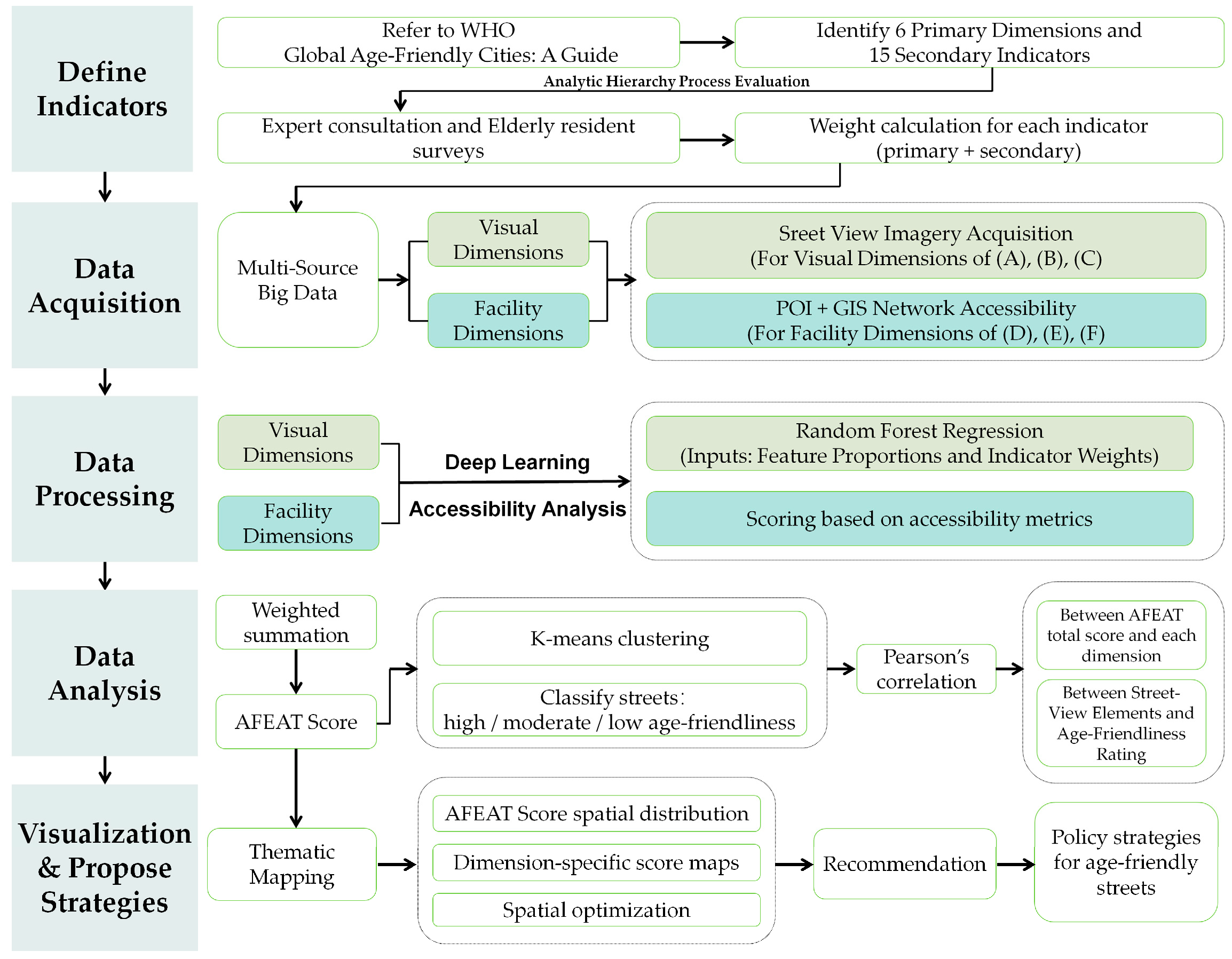
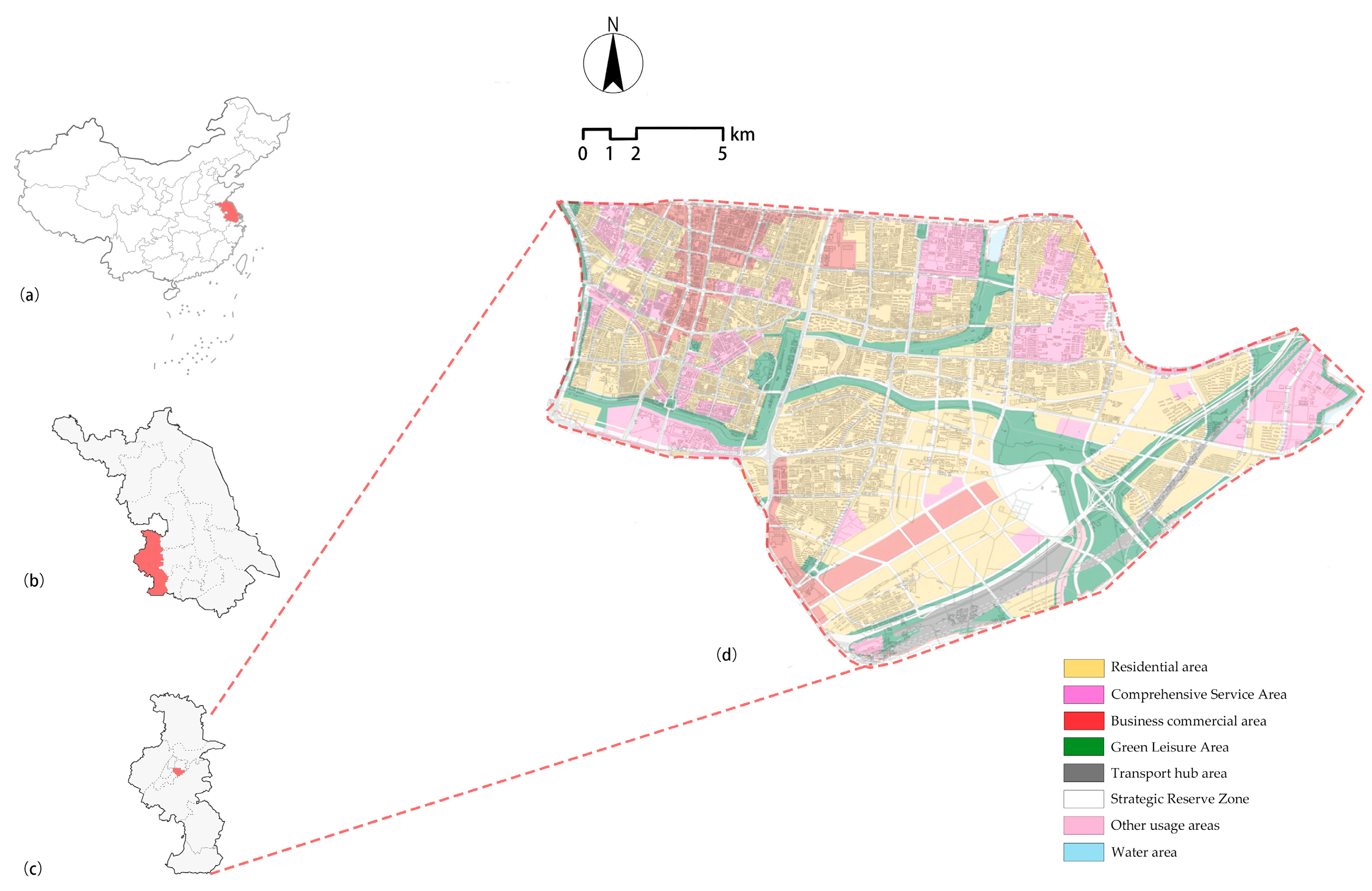

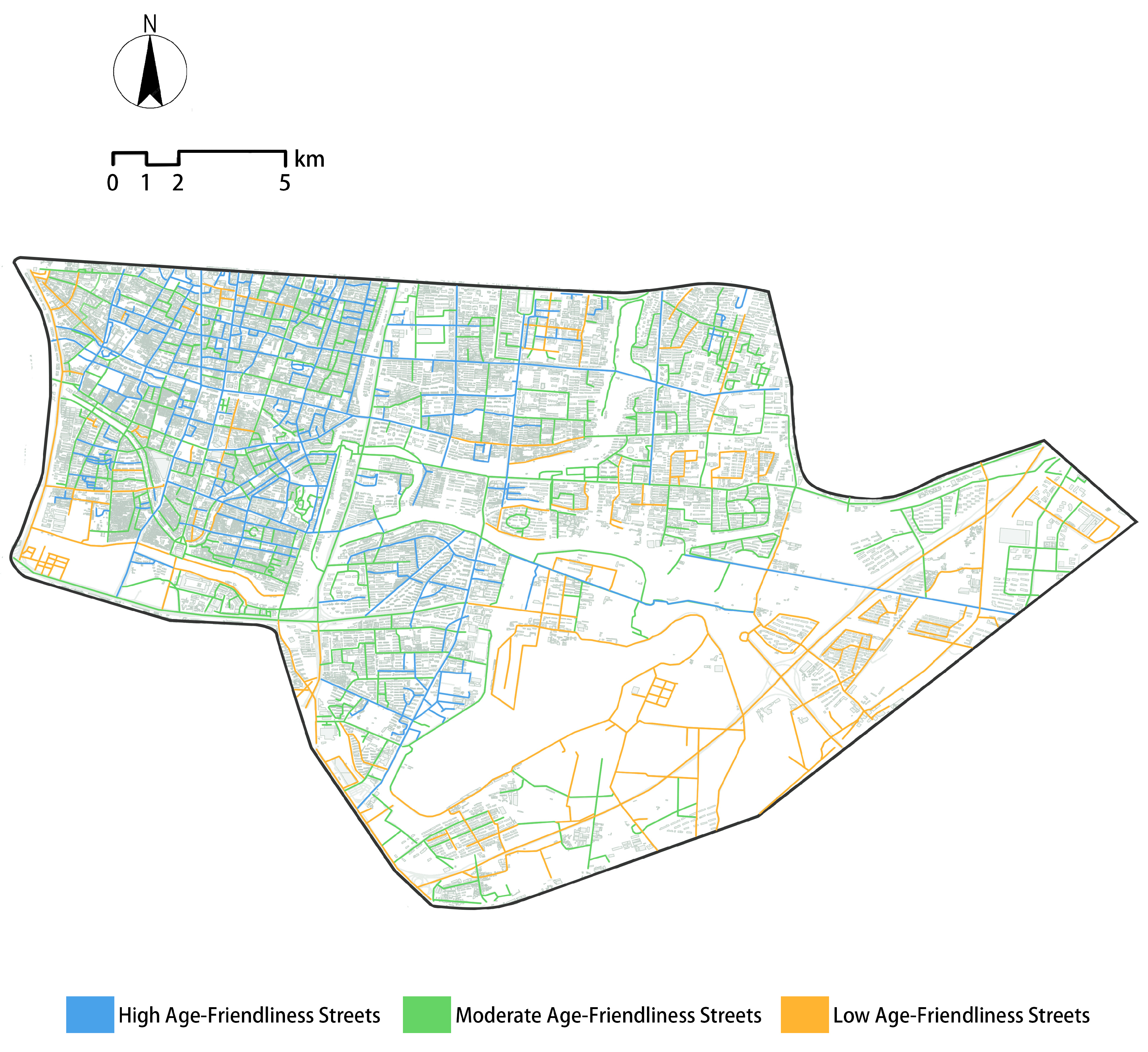
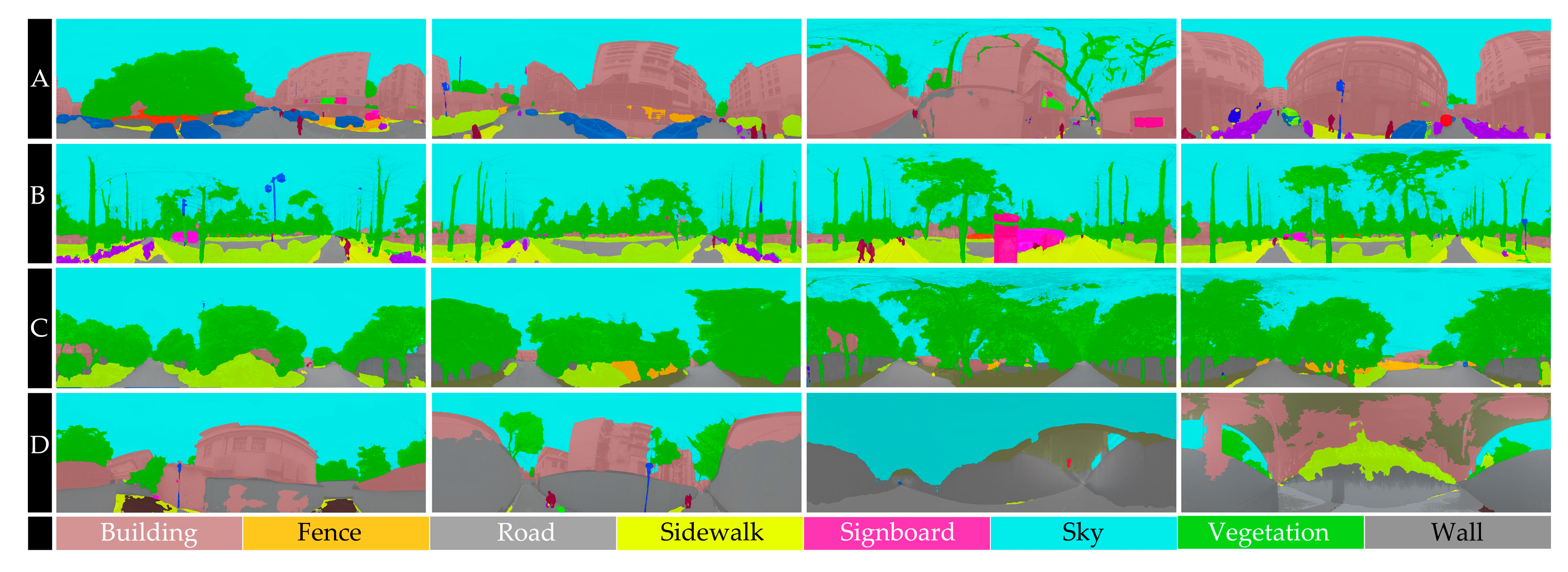
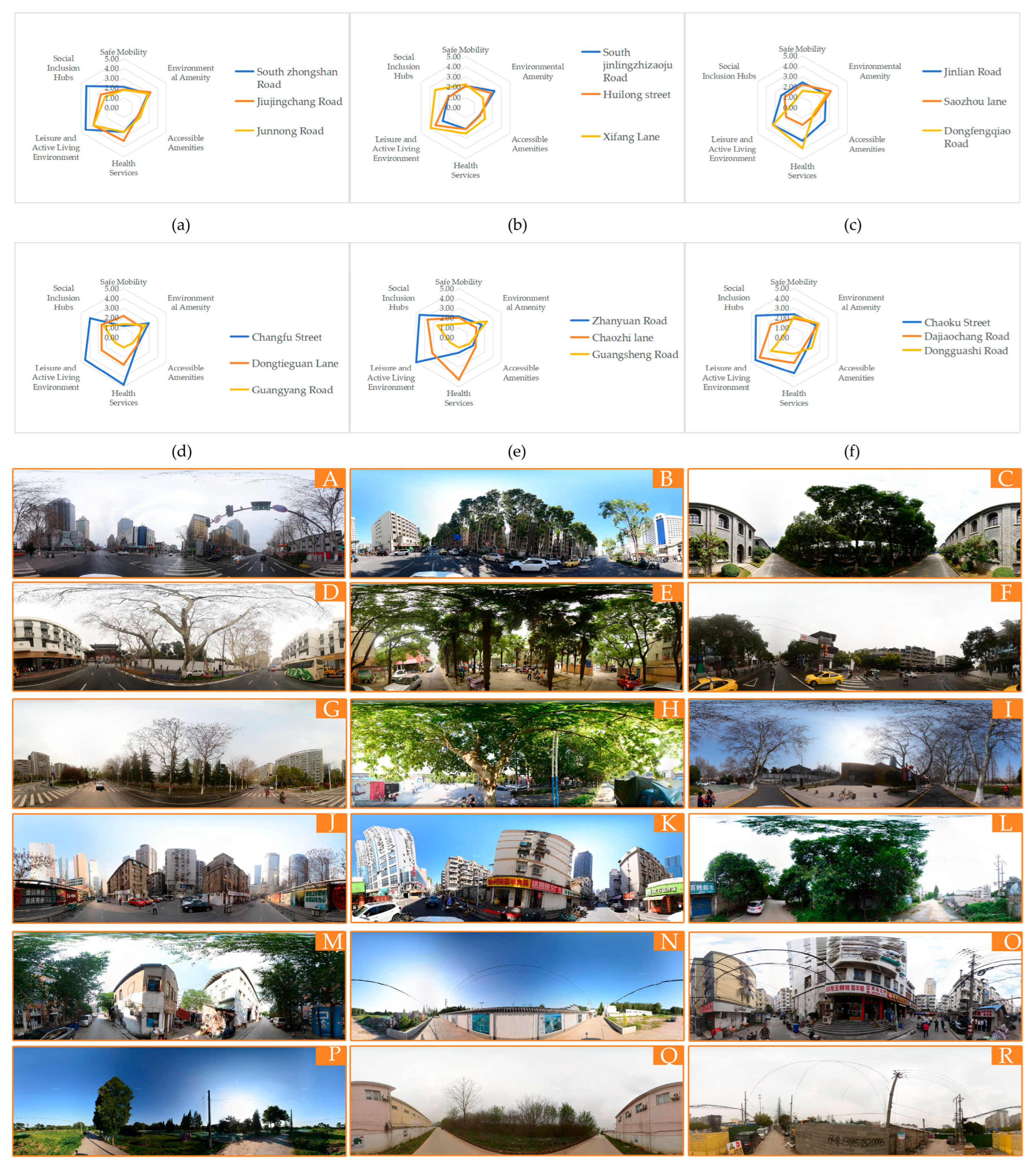
| Dimensions of AFEAT | Indicators |
|---|---|
| Safe Mobility(A) | Traffic Safety (A1) Transit Accessibility (A2) Barrier-free Transit (A3) |
| Walkable Environment(B) | Airflow Optimization (B1) Noise-reducing Greenery (B2) |
| Accessible Amenities(C) | Universal Access Infrastructure (C1) Organized Parking (C2) |
| Healthcare Services(D) | Medical Facility Accessibility (D1) Medical Services Accessibility (D2) Senior Care Facilities (D3) |
| Leisure and Active Living Environment(E) | Green Space Accessibility (E1) Daily Market Accessibility (E2) |
| Social Inclusion Hubs(F) | Volunteer Hub Accessibility (F1) Neighborhood Council Accessibility (F2) Transit Node Accessibility (F3) |
| Type | Dimension | Questionnaires |
|---|---|---|
| Expert | Safe Mobility | evaluate the importance of Safe Mobility in enhancing the age-friendliness of urban streets. |
| Environmental Amenity | evaluate the importance of Environmental Amenity in enhancing the age-friendliness of urban streets. | |
| Accessible Amenities | evaluate the importance of Accessible Amenities in enhancing the age-friendliness of urban streets. | |
| Health Services | evaluate the importance of Health Services in building age-friendly streets. | |
| Leisure and Active Living Environment | evaluate the importance of the Leisure and Active Living Environment in building age-friendly streets. | |
| Social Inclusion Hubs | evaluate the importance of Social Inclusion Hubs in building age-friendly streets. | |
| Older Resident | Safe Mobility | When you go out, do you think it is important to feel safe walking on the street? |
| Environmental Amenity | When you walk on the street, do you care whether the air is fresh, it is quiet, and there is enough greenery? | |
| Accessible Amenities | When going out for shopping or to see a doctor, do you think it is important that the route is easy to walk and convenient? (For example, no unnecessary stairs, no detours) | |
| Health Services | Do you think it is important to have hospitals, pharmacies, and emergency medical services near your home? | |
| Leisure and Active Living Environment | Do you think it is important to have parks, markets, or places for activities nearby? | |
| Social Inclusion Hubs | Do you think it is important to have opportunities to chat with neighbors or join community activities? |
| Age-Friendliness Dimension | Weight from Expert Perspective | Weight from Older Resident Perspective | Composite Weight |
|---|---|---|---|
| Safe Mobility | 0.248 | 0.218 | 0.233 |
| Walkable Environment | 0.143 | 0.197 | 0.170 |
| Accessible Amenities | 0.129 | 0.170 | 0.150 |
| Healthcare Services | 0.203 | 0.219 | 0.211 |
| Leisure and Active Living Environment | 0.114 | 0.092 | 0.103 |
| Social Inclusion Hubs | 0.162 | 0.104 | 0.133 |
| Age-Friendliness Dimension | Low Age-Friendliness | Moderate Age-Friendliness | High Age-Friendliness |
|---|---|---|---|
| (A) Safe Mobility | 19.80% | 54.46% | 25.74% |
| (B) Walkable Environment | 18.81% | 45.05% | 36.14% |
| (C) Accessible Amenities | 22.28% | 46.53% | 31.19% |
| (D) Healthcare Services | 21.78% | 44.06% | 34.16% |
| (E) Leisure and Active Living Environment | 15.35% | 42.08% | 42.57% |
| (F) Social Inclusion Hubs | 27.23% | 37.13% | 35.64% |
| overall age-friendliness index | 19.31% | 52.97% | 27.72% |
| Pearson Correlation Analysis | ||
|---|---|---|
| Dimensions | Correlation Coefficient | p-Value |
| Safe Mobility (A) | 0.259 ** | p < 0.01 |
| Walkable Environment (B) | –0.104 | 0.140 |
| Accessible Amenities (C) | 0.235 ** | 0.001 |
| Healthcare Services (D) | 0.846 ** | p < 0.01 |
| Leisure and Active Living Environment (E) | 0.693 ** | p < 0.01 |
| Social Inclusion Hubs (F) | 0.719 ** | p < 0.01 |
| Element | N | Range | Min | Max | Sum | Mean | Std. Deviation | Variance |
|---|---|---|---|---|---|---|---|---|
| Building | 202 | 0.588 | 0 | 0.588 | 45.201 | 0.224 | 0.126 | 0.016 |
| Sky | 202 | 0.616 | 0.061 | 0.677 | 83.703 | 0.414 | 0.104 | 0.011 |
| Road | 202 | 0.161 | 0.005 | 0.166 | 17.07 | 0.085 | 0.031 | 0.001 |
| Sidewalk | 202 | 0.154 | 0 | 0.154 | 4.177 | 0.021 | 0.015 | 0 |
| Wall | 202 | 0.123 | 0 | 0.123 | 3.794 | 0.019 | 0.024 | 0.001 |
| Vegetation | 202 | 0.709 | 0 | 0.709 | 33.809 | 0.167 | 0.1 | 0.01 |
| Fence | 202 | 0.053 | 0 | 0.053 | 1.666 | 0.008 | 0.009 | 0 |
| Signboard | 202 | 0.018 | 0 | 0.018 | 0.518 | 0.003 | 0.002 | 0 |
| Street-View Element | Pearson’s r | Significance (p) | Correlation Direction |
|---|---|---|---|
| Building | 0.301 | <0.001 | Positive |
| Sidewalk | 0.181 | 0.01 | Positive |
| Road | 0.133 | 0.06 | Not significant |
| Sky | −0.268 | <0.001 | Negative |
| Wall | −0.295 | <0.001 | Negative |
| Vegetation | 0.002 | 0.98 | Not significant |
| Fence | −0.042 | 0.548 | Not significant |
Disclaimer/Publisher’s Note: The statements, opinions and data contained in all publications are solely those of the individual author(s) and contributor(s) and not of MDPI and/or the editor(s). MDPI and/or the editor(s) disclaim responsibility for any injury to people or property resulting from any ideas, methods, instructions or products referred to in the content. |
© 2025 by the authors. Licensee MDPI, Basel, Switzerland. This article is an open access article distributed under the terms and conditions of the Creative Commons Attribution (CC BY) license (https://creativecommons.org/licenses/by/4.0/).
Share and Cite
Liu, X.; Lv, Y.; Li, W.; Peng, L.; Wu, Z. Assessment of Age-Friendly Streets in High-Density Urban Areas Using AFEAT, Street View Imagery, and Deep Learning: A Case Study of Qinhuai District, Nanjing, China. Buildings 2025, 15, 3518. https://doi.org/10.3390/buildings15193518
Liu X, Lv Y, Li W, Peng L, Wu Z. Assessment of Age-Friendly Streets in High-Density Urban Areas Using AFEAT, Street View Imagery, and Deep Learning: A Case Study of Qinhuai District, Nanjing, China. Buildings. 2025; 15(19):3518. https://doi.org/10.3390/buildings15193518
Chicago/Turabian StyleLiu, Xiaoguang, Yiyang Lv, Wangtao Li, Lihua Peng, and Zhen Wu. 2025. "Assessment of Age-Friendly Streets in High-Density Urban Areas Using AFEAT, Street View Imagery, and Deep Learning: A Case Study of Qinhuai District, Nanjing, China" Buildings 15, no. 19: 3518. https://doi.org/10.3390/buildings15193518
APA StyleLiu, X., Lv, Y., Li, W., Peng, L., & Wu, Z. (2025). Assessment of Age-Friendly Streets in High-Density Urban Areas Using AFEAT, Street View Imagery, and Deep Learning: A Case Study of Qinhuai District, Nanjing, China. Buildings, 15(19), 3518. https://doi.org/10.3390/buildings15193518







